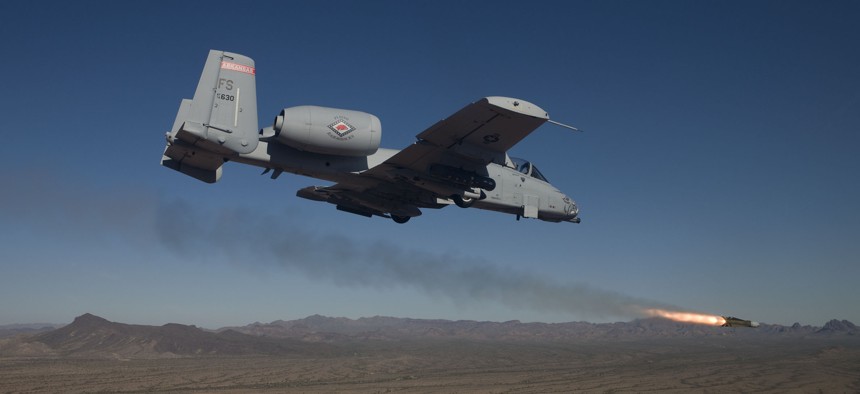
An A-10C Thunderbolt II with the 188th Fighter Wing, Arkansas Air National Guard conduct close-air support training Nov. 21, 2013, near Davis-Monthan Air Force Base, Ariz. U.S. Air Force photo by Jim Haseltine
US Air Force Needs the F-35 and A-10: Outgoing Secretary
As the Obama administration’s time grows short, Deborah James puts in a word for two polarizing aircraft.
The U.S. Air Force needs the F-35 Joint Strike Fighter and A-10 Warthog, outgoing Secretary Deborah Lee James said, of the two planes that have polarized debate throughout her tenure.
Most recently, the Lockheed Martin-made F-35 was thrust into the national spotlight by President-elect Donald Trump, who tweeted about its long history of cost overruns and said that he has asked rival Boeing to “price-out a comparable” F/A-18 Super Hornet.
On Friday, James replied that it would be “apples and oranges” to compare the older plane to the F-35.
“It does not fulfill the same requirements,” she said at a breakfast sponsored by the Air Force Association. “It’s a very fine fourth-generation fighter. The F-35 is an extremely fine fifth-generation fighter...It’s a cut above anything the pilots have seen before and we need it and we want it in the inventory.”
Trump’s tweets have been largely viewed as a tactic to drive down the cost of the F-35 ahead of Pentagon-Lockheed negotiations later this month for a batch of more than 90.
James cited Gen. David Goldfein, the service’s chief of staff.

Clockwise from upper left: an F-35C launches an AGM-154 Joint Standoff Weapon over the Atlantic Test Ranges, March 2016; an A-10 fires a volley of 30-millimeter rounds at a target on the Saylor Creek Range in Idaho, Oct. 2010; an F-35C flying with the internal weapons bays open loaded with AIM-120 Advanced Medium-range air-to-air missiles over Maryland, Jan. 2013; and an A-10 during close-air support training near Davis-Monthan Air Force Base, Ariz., Nov. 2013. (Photos via Defense Department)
“Everything that I know from the chief requirements officer of the Air Force — namely the chief of staff — is that the requirements of the F-35 are crucial and that the program is coming along.” she said. “Certainly all additional cost controls and efficiencies are extremely appreciated…but as far as the capabilities of the F-35…it’s performing magnificently.”
James also said she would expect the Trump administration to consult with Goldfein — the Air Force’s top general and a member of the Joint Chiefs — before altering the project.
Read more:
A Glimpse At How the F-35 Will Help the Marines Storm the Beach
See also:
The Air Force Wants a New Plane to Replace A-10, Fight ISIS
Another plane that appears to be going nowhere anytime soon is the A-10. Last year the Air Force backed off plans to immediately retire the venerable attack plane, saying it was needed in the bombing campaign against Islamic State militants in Iraq and Syria.
“Our feeling about the A-10 is that we would suggest certainly delaying the retirement,” James said. “It’s been extremely helpful in the fight overseas against [ISIS] as well as for presence in the Pacific and in Europe.”
The Air Force’s fiscal 2014 budget proposal to retire the A-10 stirred controversy and sparked an intense debate. The A-10 was built specifically to fly low and slow over the battlefield to support ground troops with its 30-millimeter cannon. The F-35 is seen more like a Swiss Army Knife, able to do a wider swath of missions, such as air-to-air combat, electronic warfare and close-air support.
Air Force leaders have said many times that decision to retire the A-10 was largely driven by money needed for higher priority projects. James reiterated that argument Friday and said it applied to not just the A-10, but other old planes in the Air Force’s inventory.
“But eventually [the A-10] would be the aircraft that would need to give way to the next generation as we bring on more of the newer aircraft into the inventory,” she said.
And that means the size of the Air Force budget will dictate how long the A-10 sticks around.




